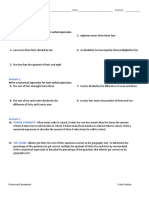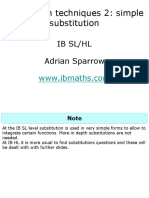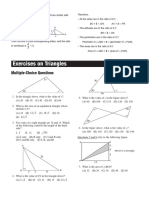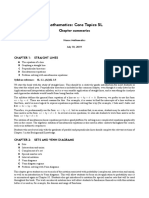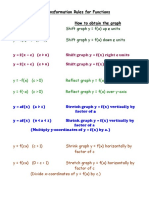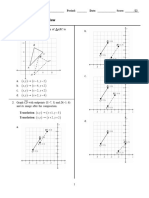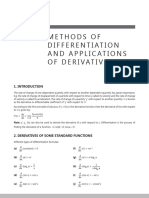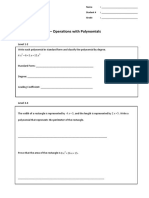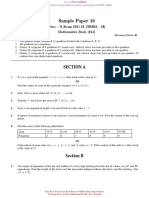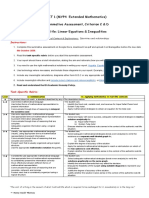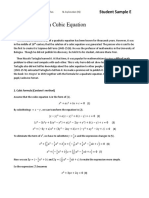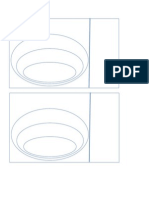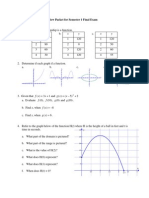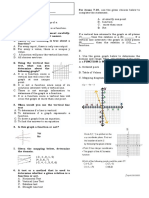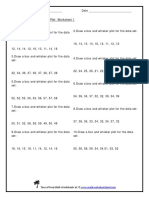0 ratings0% found this document useful (0 votes)
254 views90 pagesChapter 1 Functions
Uploaded by
25arthurd18Copyright
© © All Rights Reserved
We take content rights seriously. If you suspect this is your content, claim it here.
Available Formats
Download as PDF or read online on Scribd
0 ratings0% found this document useful (0 votes)
254 views90 pagesChapter 1 Functions
Uploaded by
25arthurd18Copyright
© © All Rights Reserved
We take content rights seriously. If you suspect this is your content, claim it here.
Available Formats
Download as PDF or read online on Scribd
You are on page 1/ 90
McGraw-Hill Ryerson
Functions 11
Authors Consultants, Advisors
Roland W. Meise! Assessment Consultant Kirsten Boucher
BSc., BEd, MSc. Antonietta Lenjosek Durham District School Board
Post Colborne, Ontario Ottawa Catholic School Board Patricia Byers
avd petro Georgian Collegs
Be. (Hons), BEd, MSe. ‘Tecnology Consutants chs beating
Windsor Esex Caio Distct, sieastearte
Wino Ev ban ciarmai Baringo, O
me Hamilton-Wentworth District Ot Steven} Desjardins
Jacob spel Shoo! Bouré University of Otewa
B.Eng.. M.Sc.Ed.., P.Eng. Roland W. Meisel Karen Frazer
Distt School Bourd of Niagara
Dist Ses Port Colborne, Ontario Ota Cereton District Schol
Bou
Se (ons), Bd Matematica Processes aa
York Region District School concuttant a
Board Bluoweter District School Board
Barb Vukets: eal, Jeff Irvine
B.Ed., M-Ed. ‘Toronto, Ontario Peel District School Board
Watioofogion Distt School way constant Catleen Morguls
Board = ‘Durham Catholic District School
Caro oa =
Contributing Authors Toronto District Schol Board rae Penkowst
Bryce Sates Toronto Distt School Board
Toronto District School Board Pedagogical Consultants, ‘Antonio Stancati
Kisten Boucher Aronia enosek Toronto Catholic Distt Schoo
Durham District School Boerd Ottawa Catholic Scheol Board Board
Mary Card {Larry Romane
‘Toronto District School Board ‘Toronto Catholic District Schoo!
‘Wayne Erdman Bow
Toronto Distct Schoo Board enlar Program Constant
fob Gleeson
Wayne Erdman
Bluewater Diseit School Board Teron District Schcol Board
ay McGraw. Hit
Ryerson
Toronto Montréal Boston Burr Ridge, IL Dubuque, A. Madison, WI_ New York
San Francisco St.Louis Bangkok Bogoté Caracas Kuala Lumpur Lisbon London
Madrid Mexico City Milan New Delhi Santiago Seoul Singapore Sydney Taipei
COPIES OF THIS BOOK
MAY BE OBTAINED BY
ANTACTING:
McGraw-Hill Ryerson
Ld.
EMAIL:
onderstamegrawhil.ca
‘TOLL-FREE FAX:
‘TOLL-FREE CALL:
1-800-565-5758
‘OR BY MAILING YOUR
‘ORDER TO,
MoGrave- Hill Ryerson
Onder Department
300 Water Strest
‘Whitby, ON LAN 86
Plesse quot the ISBN
and tte when placing
your order
Student Text ISBN
978-0-07-000078-3
Cc
‘McGraw-Hill Ryerson
Functions 12
Copyright © 2000, McGraw-Hill Ryerson Limited, s Subsidy of The McGraw Hl
Companies, All sights reserved. Ne part ofthis publication may be eproducod oF
‘unnsmitted in any form or by any ean, o stored in a database or rerieval
system, sithout the prior weltlen permission of McGrave-Hill Ryerson Lim
fof in the case of photocopying or other reprographic copying licens from the
Canadian Copyright Licensing Agency (Accers Copyright) Ravan Areas Capyright
licence, call fll fee to 1-800-898°5777
‘Any soquest for photocopying, recording, oF taping of this publication shall be
‘zecod in writing to Accass Copycght
ISBN-19: 9780-07-000078-3
ISBN-10;0-07-000078-3,
456789 TCP198 765432
Printed and bound in Canad
Caro has boon taken to trace owneship of copyright materiel contained in this text.
‘The publishers will gladly accept any information that will enable thom to rectify
any reference or credit in subsoquont printings
‘The Geometers Sketchpad® and Fathom Dynamic Statistcs™ Software,
Key Curriculiim Pres, 150 68th Siret, Emeryville, CA 04608, 1800-008. MATH
“Microsoft® Excol isa togistored trdomark of Microsoft Corporation inthe United
States and/or other countries.
TLNepiro™ and CBR™ are trademarks of Toxas Instruments Incorporated
‘Statistics Canada information is weed with the permission of Statistics Canada,
Users ere forbidden to copy te data and rodissominate them, in an original ot
‘modified form, for commercial purposes, without pormission from Statistics
CCansda, information onthe avaleility ofthe wide range of data from Statistics
Cenacle can be obtained from Statistics Canada’s Regional Ole, and its tall-iee
ccens number 1-800-263-1136.
PUBLISHER: Linda Allon
‘ASSOCIATE PUBLISHER: Kristi Clark
PROJEGT MANAGERS: Maggie Chovoro, Janice Dyer
DEVELOPMENTAL EDITORS: Maggle Cheverl, Jacqueline Lacou
Darren McDonald, Peul MeNulty
MANAGER, EDITORIAL SERVICES: Crystal Shortt,
SUPERVISING EDITOR; Janle Deaeat
COPY EDITING: Julia Cochrane
PHOTO RESEARCH: Maria De Cambro, Monika Schurmann
EDITORIAL ASSISTANT: Erin Hatley
REVIEW COORDINATOR: jenalee Keay
MANAGER, PRODUCTION SERVICES: Yolanda Pigdon
PRODUCTION COORDINATOR: Paula Brown
COVER DESIGN: Michelle Losior
INTERIOR DESIGN: Valid Design and Layout
‘ART DIRECTION; Brian Lehen Graphic Design La,
ELECTRONIC PAGE MAKE-UP: Brian Lehen Graphic Design Lid
‘TSCHNICAL ART: Brian Lahen Graphic Design Lt.
COVER IMAGE: ©Andeew KoralakiGaty images
i Contents
Preface
Chapter 1 Functions 1
Proroguisite Skills 2
4.1. Functions, Domain, and Range 4
1.2 Functions and Function Notation 16
1.3 Maximum or Minimum of a Quadratic
Function 25
Use Technology Use a TI-Nspire™ CAS
Graphing Calculator to Find Maximum,
‘or Minimum and the Zeras of a
(Quadratic Function 33
114 Skills You Need: Working With
Radicals 34
Use Technology Use a TINspire™ CAS
Graphing Calculator to Explore
Operations With Radicals a"
1.5. Solve Quadratic Equations 8
1.6 Determine a Quadratic Equation
Given its Roots 52
1.7 Solve Linear-Quadratic Systms 60
‘Chapter 1 Review 70
chapter 1 practic Test 2
Task: Las 74
Chapter 2 Transformations of
Functions 5
Proroguisite Skills 76
2,1 Functions and Equivalent Algebraic
Expressions 18
Use Technology Graph Functions Using a
‘TLNspire™" CAS Graphing Calculator 86
2.2 Skills You Need: Operations With
Rational Expressions 88
2. Horizontal and Vertical Translations
of Functions 97
24. Reflections of Functiont 105
25. Stretches of Functions n3
Use Technology Use The Geometer's
‘Sketchpad® to Explore
‘Transformations 123
2.6 Combinations of Transformations 125
Ww PH Functions 11 + Contents
2.7 Inverse of a Function 132
Chapter 2 Review 142
Chapter 2 Practice Test 144
Task: Functions in Design 146
Chapter 3 exponential Functions 147
Proroqusite Skills 148
3.1 Tho Nature of Exponential Growth 150
Use Tecnology Use Lists and Trace Features
fon a TENspire™ CAS Graphing
Calculator 158,
3.2 Exponontial Decay: Connecting to
[Negative Exponents 160
3.8 Rational Exponents 170
34 Properties of Exponential Functions 178
3.5 Transformations of
Exponential Functions 188,
3.6 Making Connections: Tools and
Stratogns for Applying Exponential
Models 199
chapter 3 Review 210
Chapter 3 Practice Test az
Chapters 1 to 3 Review 214
‘Task: Rasioactive Isotopes 218
Chapter 4 Trigonometry 219,
Prerequisite Skills 220
41 Special Angles zee
4.2 Co-erminal and Related Angles 232
Use Technology Use a Computer Algobra
System to Find Exact Trigonometric
Ratios and Angles pat
4.3 Reciprocal Trigonometric Ratios 243,
44 Problems in Two Dimensions 249
Use Techrology Use Geometry Software to
‘Test for the Ambiguous Case 259
4.5 Problems in Three Dimensions 261
44.6 Trigonometric Identities 270
Chapter 4 Review 276
Chapter 4 Practice Test zr8
Task: Pyramids and Angles of Elevation 200
Acknowledgements
Reviewers of Functions 11
‘The publishers, authors, and editors of McGraw-Hill Ryerson Functions 11 wish to extend their
sincere thanks to the students, teachers, consultants, and reviewers who contributed their time,
fenorgy, and expertise to the creation of this textbook. We are grateful for their thoughtful commonts
fand suggestions. This feedback has been invaluable in ensuring thatthe text aud related teacher's
resource meet the needs of students and teachers.
John Giroux
[Niagara Catholic District Schoo! Board
Russell Gordon
Peel District Schoo! Board
Beverly Hitchman
Upper Grand District School Board
Paul Hargot
Hamilton-Wentworth Catholic District School
Board
Ursula Irwin
‘Simcoe County District School Board
‘Murray Johnston
Halton District School Board
David Keffer
Durham Catholic District School Board
Jone Lee
‘Toronto District School Board
Sheila Mascarin
Halton Catholic District School Board
Ria MeNicholls-Romrattan
Peel District School Board
‘Dedication
Donald Mountain
‘Thames Valley District School Board
‘Mare Nimigan
‘York Region District School Board
Tina Poldervaart
Upper Canada District School Board
Monica Preiner
Halton Distrist School Board
Silvia Rotolo
‘Toronto Catholic District Schoo! Board
Mary Schofield
‘Thames Valley District School Board
Peggy Slegers
‘Thames Valley District Schoo! Board
Robert Slemon
‘Toronto District School Board
Naney Tsiobanos
Daffetin-Peel Catholic District School Board
‘Sharon Young
Halton District School Board
“The Functions 11 resource is dedicated in honour of John Santarelli. John was an outstanding
-educatorand mentor who had the unique ability to understand the needs of all students and
teachers, He put his actions into words by conceptualizing and developing the best possible
material, We are grateful to have had John’s expertise with the initial development ofthis resource.
John’s spirit, laughter, and friendship will be truly missed.
Linda Allison
Mathematics Publisher
Chapter 5 Trigonometric Functions 231
Prerequisite Skills 282
5.1 Modelling Periodic Behaviour 284
5.2 The Sine Function and the Cosine
Function 204
Use Technology Dynamically Unwrap the
Unit Circle 302
5.3 Investigeto Transformations of Sine
and Cosine Functions 304
5.4 Graphing and Modelling with
y= asin{k(x ~ d)) + cand
y= acoslkix ~ d)] + 6 na
5.5 Data Collecting and Modelling 322
5.6 Use Sinusoidal Functions te Model
Periodic Phenomena Not Involving
‘Angles 333
Use Technology Create a Scatter Plot and
1 Function Using a TENspire™ CAS
Graphing Calculator 343
‘Chapter 5 Review 344
Chapter 5 Practice Test 346
Chapters 4 and 5 Review 348
t
Modeling a Rotating Object 350
Chapter 6 Discrete Functions 351
Prorequisite Skills 352
61 Sequences as Discrete Functions 354
\Uge Technology Use 2 TINspiro™! GAS
Graphing Calculator to Write Terms
Ina Soquence 364
62. Recursive Procedures 365
63 Pascal's Triangle and Expanding
Binomial Powers 373
64 Arithmetic Sequences 380
65 Geometric Sequences 388
66 Arithmetic Series 395
67 Coometsic Series 402
‘chapter 6 Review 410
Chapter 6 Practice Test 412
“Task: Mathematles in Media Studies 414
Chapter 7 Financial Applications
Prerequisite Skills
7.1. Simple Intorost
7.2 Compound Interest
7. Present Value
74 Annuities
7.8 Present Value of an Annuity
‘Chapter 7 Review
‘Chapter 7 Practice Test
‘chapters 6 and 7 Review
‘Task Loans and Annuities Due
‘Course Review
Prerequisite Skills Appendix
Technology Appendix
Answers,
Glossary
Index
Credits
41s
416
418
426
436
444
456
464
468,
470
au
478
496
517
587
595,
600
Contents *MHB V
i Preface
‘McGraw-Hill Ryerson Functions 11 is designed for students planning to
‘qualify for college or university. The book introduces new mathematical
principles, while providing a wide varity of applications linking the
‘mathematical theory to real situations and careers.
Text Organisation
‘ Chapcr 1 introduces the concept of a function and associated notation,
ear, quadratic, reciprocal, and radical functions, their domain and
range, and other key properties are explored
¢ In Chapter 2, you will learn how the equations of functions show related.
‘wanslormations,
‘© In Chapter 3 you extend your knowledge and understanding of
exponents and apply the concepts to exponential functions
‘© Chapier 4 extends your understanding of trigonometry by defining
‘rigonometric ratios of any angle and solving oblique triangles, These
‘concepts are then used in Chapter 5 to analyse trigonometric functions.
‘© In Chapter 6, concepts of arithmetic and geometric sequences and serios
are daveloped. In Chapter 7, these concepts are applied to financial
situations iva
wple and compound interest and annuities
Mathematical Processes
‘© This toxt intogrates the soven mathematical processes: problem solving,
reasoring and proving, reflecting, selecting tools and computational
strategies, connecting, representing, and communicating. These
are interconnected and are used throughout the course. Some
examples and exercises are flagged with a math processes graphic to
show you which processes are involved in solving the problem.
Chapter Features
‘© The Chapter Opener introduces what you will leam in the chapters. It
incluces alist ofthe specific curriculum expectations that the chepter
‘¢ Prerequisite Skills roviews Key skills from previous mathematical
courses that are needed to be successful with the current chapter.
Examples and further practice are given in the Prerequisite Skills
Appendix on pages 478 to 495. The Chapter Problem is introduced at
the ond of the Prerequisite Skills. Questions related to this problem are
identified in the exercises, and the Chapter Problema Wrap-Up is found.
at the end of the Chapter Review.
IMR = Functions 11 = Preface
‘© Most numbered sections start with an Investigate which allows
you to constrict your own understanding of new concepts. Many
‘of these investigations are best done using graphing calculatars or
dynamic geometry software, but in most instances the choice of
tool is options.
‘© Worked Examples provide model solutions that show how
the new concepts are used. They often include more than one
method, with and without technology. New mathematical terms are
r ‘and defined in context. Refer to the Glossary on pages
587 to 594 for a full list of definitions of mathematical terms used in
the text.
‘© The Key Concepts box summarizes the ideas in the lesson, end the
Communicate Your Understanding questions allow you to reflect
‘on the concepts of the section.
© Exercises are organized Into sections A: Practice, B: Connedt and
‘Apply, and C Extend. Any questions that require technology tools.
are identified as Use Technology. Most C exorcises end with a few
‘Math Contest questions to provide extra challenge.
‘© Each chapter ends with a section-by-soction Chapter Review.
‘Cumulative Reviews occur after chapters 3,5, and 7.
A Practice Test is also included at the end of each chapter.
‘© A Task is presented atthe end of each chapter. These are more involved.
‘problems tha: require you to nee saveral cancepts from the preceding
chapters. Some tasks may be assigned as individual or group project,
‘© A Course Reriew follows the task at the end of Chapter 7. This
comprehensive selection of questions will help you to determine if you
are ready forthe final examination.
Preface + MAR vil
Assessment
‘© Some questions are designated as an Achievement Check. These
‘questions provide you with an opportunity to demonstrate your
knowledge and understanding, and your ability to apply, think about,
and communicate what you have learned.
© The Chapter Problem Wrap-Up occurs at the end of the Chapter
Review. Itconsists of a summary problem, and may be assigned as a
project
Technology
‘© The text shows examples of the use of the TI-89Plus or TI-84Plus
graphing calculator, The Geometor's Sketchpad®, Fathom Dynamic
Statistics™ Software, and Microsoft® Excel spreadsheets.
‘© The TENspire™ CAS calculator is introduced as an alternative tool.
Use Techology’
‘These optional features use technology to extend the concepts
of the preceding sections. Techniques with the TI-Nspire™ CAS
calculator or extensions with The Geometer’s Sketchpad® provide
you with interesting activities to challenge and engage you in new
‘mathematical ideas.
‘Connections
‘This margin item includes:
‘© connections between topics in the course, or to topics leamed previously
«interesting facts related to topics in the examples or exercises
‘© suggestions for how to use the Internet to help you solve problems or
to research or collect information—direct links are provided on the
Functions 11 page on the McGraw-Hill Ryerson Web site.
Answers:
© Answors to the Preraqusite Skills, numbered sections, Chapter Review,
1nd Practice Test are provided on pages 517 to 586.
«© Responses for the Investigate, Communicate Your Understanding,
Achievement Check juestions, and Chapter Problem Wrap-up are
provided in MeGrawHill Ryerson Functions 11 Teacher's Resource.
«© Fall solutions to all questions, including proof questions, are on the
‘MeGraw-Hill Ryerson Functions 11 Solutions CD-ROM.
Vl MAR.» Functions 17 «Preface
Functions
In previous mathematics courses, you have
studied linear relations and some non-linear
relations. In dhis chapter, you will leam what
distinguishes some relations as functions. You
will represent functions in a variety of forms,
{identify the domain and range of functions, and
investigate the behaviour of graphs of functions.
Your understanding of the quadratic function will be
extended and you will learn how to determine the intersection
ofa linear function and a quadratic function. You will apply
knowledge of quadratics to real-life situations, including how to model the
arch of the support of a bridge.
or
Atanas
© explain the meaning ofthe tem function and
fisingush 3 fnction rom areation hat sot
& function trai investigation of reat and
{usc lating ung a varey of representations
« ‘epresent lines and quadatic function using
function nota even thei equations, tables of
values, or gop, and substitute info and evaluate
functions
«expan the meanings of he ters domain and range
‘rough investepton using numer grphical and
atgetrac representations ofthe functions fe = x.
$12) = fl) =-V%. and f(x) = +: describe the domain
and range of afunction ppropttly and explain
any restreon on hedaman and rengein contexts
aking fom rested aplications
«determine thenombar af 208 of a quetatic
function using a vat of suategies
«@ catemine theme of minimum vue of a
{uaatlcunclon whose equations given inthe
foum fe) = 0 be + using an algae method
solve problems involving quadratic function aising
from reak-worid applications ané represented using
function notation
determine through investigation, the
‘wansfarmational relationship among the fami of
‘quadratic functions that have the same zeros, and
determine the algebraic representation of a quadratic
function ven the real oots ofthe coesponding
‘qacratic equation and a point an the function
solve problems involving the intersection of alinesr
function and a quacratc function graphically and
algebraically
vert, tough investigation with and without
‘technology, that Vab = Va x Vb, a2 0 and
(b> 0, and use this relationship to simplify radicals
and radical expressions obtained by adding,
subvacting and muttilying
Prerequisite Skills
Refer to the Prerequisite Skills Appendix on
‘pages 478 to 495 for examples of the topics and
Jarther practice.
Graphs and Lines
1. Graph each Linear relation,
ay=ax-4 oy
away +32
ay
2, Determine the equation in the form
y= mx + b for each linear relation,
3. Determine the equation in the form
3g through
mx + b for the line pa
‘each pair of points.
2) (0, 8) and (4, 3)
b) (~8, 13) and (2, ~2)
9 (4, -1) and (22, 9)
4. Graph each pair of linear rel
their point of intersection,
a) ym 2x4 4and y=
ay y= By —vandy= 2x +5
0) 3x 5y = ~4 and -24 + 3y
jons to find,
wea
2 MAR Functions 11 «Chapter 1
5. Use an algebraic method to find the point of
{intersection of each pair of lines.
a) y=ax+5
2x = y =
byaxta
yrmna
oxy
2x ~y 13
‘Work With Polynomiats:
6. Expand and simplify each expression,
a +2" b) (n+ 30-3)
a le- ar ate + ax 2)
94 -k-1) 1) Zox- DaK +9)
7. Factor complealy.
eee Bt Hort
©) one = 25 a -e-x41
ear setts 1) ~5x* + 40x ~ 80
Identify if each quadratic expression is @
perfect square trinomial, For the perfect
square trinomials, write the factored form.
ays ex4 by x= 12K +96
Qaetart1 deers
es taxts 1) ant +120 +9
9. What value of k makes each quadratic
expression a perfect square trinomial?
ays toxtk b) 10x +k
8 -axth @) 4 uxtk
ee tixtk ) e-uetk
avtxtk hy x ax +k
‘10. Factor out the rational coefficient of the
xterm in each,
ah
of
ody +5
9- a-t
+ 9x
Quadratic Relations:
11, For each quadratic rel
2, state
1) the coordinates of the vertex
{i the equation of the axis of symmetry
tty the direction of opening
Iu) the yrintercept
‘Then, sketch a graph of the relation.
ay y= 2x41 -3
by
. 13, Complete the square to express each,
or ay +a quadratic relation in the form
ym alx ~ h + k Then, give the
‘coordinates of the vertex.
a
12, Determine the equation of the quadratic
relation that corresponds to each graph.
Each graph has the same shape as y = x" ay
by y= xt 10x
wean kd
5
14, Without graphing, predict how the graphs
‘of the equations in each pair will differ
Explain your reasoning.
a) y=(x-+ Sand y= (x45 42
bp yaa axe sandy — x! 4x
15, Use Technology Verify your answers to
question 14 by graphing the two equations
using a graphing calculator.
_ Chapter Problem
‘Andrea has a co-op placement
at an actuarial firm. Actuarial
science applies mathematical
and statistical methods to assess
risk for insurance providers and
financial institutions. Andrea's
assignments include collecting
numerical data and developing
equations for these businesses.
‘Throughout the chapter, you
will be looking at a varioty of
tasks thet Andrea has boon
given in her co-op placement.
Prevewusite Skis» MH 3
Functions, Domain,
and Range
When mathematicians and scientists recognize a relationship between items in the world around
thom, they try to model the relationship with an equation. The concept of developing an equation
{is used in other fields too. Economists predict the growth of sectors of the economy using
equations, Pollsters try to predict the outcome of an election using equations. Does the value of one
‘measured quantity guarantee a unique value for the second related quantity? This question defines
the difference botwoon a gelation and a function.
relation
+ anidentieg pattern
Between two
Varates tat may be
Fepresented as oder
pas a tale of values,
Seraph oran equation
‘ation
+ aetatonin ich
Independent varabe
(the frst coordinate)
Corresponds to exactly
fone value ofthe
dependent varabe
{the secon coordinate)
Investigate A
How can you tel if a relation is a function?
Data on summer jobs are collected from some students in a grade 11
class. Some analysis is dane to look for patterns in the data,
‘A: Neil's Time Worked and Amount Earned, by Week
fine)
20 190
18 7
25 247
22 209)
0 285)
2 228)
10 95
B: Number of Weeks Worked and Amount Earned by 10
4 MAR «Functions 11 + Chagter 1
ifferent Students
1. Graph the given sets of data, Tools
2, Deseribe any tends in the two graphs. erento
3, From the grapa of the data in table A, can you predict how much + waphing steator
[Neil would earn if he worked 28 h one week?
4. From the grapi of the data in table B, can you predict the amount
that a student who worked for 8 weeks would earn’
5. Reflect Which set of data is «function? Explain using ‘he terms
independent variable and dependent variable.
iwestigateB 0 Tools
i paper
How can you make connections between equations. graphs, and
‘functions?
Method 1:
“Tho firet Investigate illustrated that one value for the independent
variable can be associated with more than one difforent value forthe
dependent variab e. Any relation that has this property is not a function.
In this Investigate, you will laok at how this concept can be related to the
‘equation fora relation,
Pencil and Paper
1. Copy and complete the tables of valuos for the relations y = x* and
xey
2. Graph both relations on the same set of axes.
3. On the sameset of axes, draw vertical inos with equations x = ~:
2x8 1x , and x
4. Reflect Compare how the lines drawn in step 9 intersect each of the:
relations. Which relation is a Function? Explain why.
1.1 Functions Domain and Range » MARS
Tools
rohing aeator
Techlogy Append,
pages 496 10516, if
youneed hep with
ephing equation:
‘vertical Line test
+ amethoo ot
fztemining whethera
‘elton ea fonction
+ fever eral ine
Intersects the relation
‘only one point
then the elation sa
tuseton
Method 2: Use a Graphing Calculator
4. Graph ¥1 = 22
Use the siandar
Pross (Za) GRA to access the Draw menu.
+ Choose 4:Vertical
+ Use the let and right cursor arrows to move the vertical line.
‘window settings.
Ifyou press (ATH, the line willbe secured at that spot. Press
(at) ORAN)and select 1:CleDraw to remove the vertical line
3. Is y = x°a function? Explain why or why not
4. Graph x = y* by Bist solving the equation for yto abiein y = =V%.
‘Bator ¥1 = (2/905 and Y2 = ~(3)405.
5. Ropoat stop 2. Is x = y* a funetion? Explain why or why not,
Example 1 —_—————
Use the Vertical Line Test
Use the artical ie tat to determine whether each relation is a
function. Justify your answer.
6 MHR + Functions 17» Chaoter 1
Solution
1) This relation is a function.
No vertical line can be drawn
‘that will pass through more
than one point on the line.
) This relation is a not function. An
infinite number of vertical lines can be
drawn that will pass through more than
‘one point on the curve. For example, the
vertical line x = 6 passes through the
points (6, and (6, 0),
©) This relation isa function. No vertical
line can be drewn that will pass through
‘more than one point on the curve.
4) This relation is not a function. An
Infinite number of vertical linos can be
drawn that will pass through more than.
fone point on the circle.
1.1 Functions, Domain and Range * MHR 7
domain
+ thesetof fist
foordnates of he
dered pas ina
reation|
range
+ nese of second
feoramnates of te
‘gered posing
‘alton
Connections
Brace brackets Jae
ed te denote a set of
feats datapoints or
values
real number
+ anuiber inthe
Sxtotal ineges
{errinating demas,
repeating decimals,
eo-termiating
‘ecard
Secmats represented
byte soi
For any relation, the set of values of the independent variable (often
‘the x valuos) ie called tho domain ofthe zolation. The eat of the
‘corresponding values of the dependent variable (often the y-values) is
called the Fange of the relation. For a function, for each given element of,
the domain there must be exactly one element in the range.
Example 2 ll — ==»
Determine the Domain and Range From Data
Determine the domain and range of each relation. Use the domain and
range to determine ifthe relation is a function.
a) (3, 4), (5, -0), (2, 7) (6, 9}, (6, ~8))
) The table shows the number
of children of each age ata sports camp.
Solution
2) domain (~:
2, 5,6), range |-8, ~6, 3, 4,7]
‘This relation is not a fonction. The x-value x = 5 has two
‘corresponding y valuoo, y= —6 and y~ 8. Tho domain has four
‘elements but the range has five elements. So, one value in the
‘domain must be associated with two values in the range.
) domain (4,5, 6, 7, 8, 9, 10), range (5, 8, 9, 12, 12, 14, 2),
n
fn function because for each value in the domain thera is
exactly one value in the range.
When the equation of
be determined by anal
‘oumbers.
lation is given, the domain and range can
ig the allowable values from the set of reall
8 MAR Functions 11 «Chapter 1
Example 3
Determine the Domain and Range From Equations
Determine the domain and the range for each relation. Sketch a graph of
ach,
a)y=2x-
oy
iw aba ay-h
Oy=Ve-a+3 ges yase
Solution
a) y = 2x ~ 5 Is linear relation, There are no
restrictions on the values that can be chosen
for x oF y.
Connections
The otaon (x=
ISsetrotation
Isacanese wey ot
fapesing tat x any
eo number. The symbol
Emaar ison lement
on
domain [xe R) Readas he domain is area
range lye Ri unter
b) y= (x= 1) + 3 isa quadratic relation,
‘There are no restrictions on the values that
can be choson for x, o the domain is all
real numbers.
domain (x € R)
‘The parabola has a minismum
at its vertex (1, 9).
All values of y are greater than or equal to 3
range (ye Ry = 3)
«Division by zero is undefined. The expression in the denominator of
sy cannot be zero, So, x +3 #0, which means that x # ~3. All
Other values an bused for, The vet line x = =i called an
seymptoe Peni vor
domain xe. x3) Se Mamanestwanmesmtcent Sele mg
For the range, there can never be a touches
situation where the result of the division + Forexamle, forthe
is zero, as 1 divided by a non-zero value (rash of y= x. the
can never result in an answer of asad ie ye
‘This function has another asymptote, the
axis, Any real number except ~3 can
be used for x and will result in all real,
‘numbers except 0 for the range. Use a
table of values or a graphing calculator to
check this on the graph.
range ly € R, y# 0}
ARLES
1.1 Functions, Domain and Range * MH
Connections
Tn rade 10, you teamed
the sys risthe
uation ofa ede with
fete the oh and
4) The expression under a radical sign
‘must be greater than or equal to zero.
Soin V¥-2+3,x-120,
orr2 1
domain [ye R,x= 4)
‘The value of the radical is always 0
‘or greater and is added to 3 to give the
value of y. So, the y-values are always
greater than or equal to 2, This gives
the range.
range lye R, y= 3)
©) In. + y? = 36, x" must be less
than oF equal to 26, a8 must y2,
singe both x? and y* are always
positive, So, the values for x
land yare from ~6 to 6,
domain (xe R, -6= x= 6)
Read 26th domsin i area
raerbers tat oe eater than
equal to ~6 and ess than oF
equ 96
range lye R,
Example 4 — =
Determine the Domain and Range of an Area Function
‘Amy volunteers to bolp
exclose a rectangular area
fora dog run behind the
humane society. The run
is bordered on one side Fi
by the building wall
‘The society has 100m of
fencing avatiable.
3) Exprss the area function in terms of the width.
) Determine the domain and range for the area function,
10 MHR Functions 11 «Chapter 1
Solution
Lot x represent the width of the rectangular
pon and 100 ~ 2 oproaont the lengthy
both in metres. Let A represent the area, in
square metres,
2) Als) = x(100 = 23) A
= =2x8 + 1008
ngth wit
») For the domain, x > 0, since there must be a
‘width to enclose an area. For the length to
be greater than zero, x < 50
domain [xe R,0
You might also like
- MYP 4&5 Arithmetic and Geometric SequencesNo ratings yetMYP 4&5 Arithmetic and Geometric Sequences16 pages
- Principles of Math 12 - Transformations Practice Exam PDFNo ratings yetPrinciples of Math 12 - Transformations Practice Exam PDF23 pages
- Cambridge IGCSE™: Cambridge International Mathematics 0607/42 February/March 2022No ratings yetCambridge IGCSE™: Cambridge International Mathematics 0607/42 February/March 20228 pages
- Edexcel International A Level Maths Pure Mathematics 1 Wma1101 661043a991815405968c3f73 221No ratings yetEdexcel International A Level Maths Pure Mathematics 1 Wma1101 661043a991815405968c3f73 2218 pages
- H2 Mathematics Specimen Paper 2: Section A: Pure Mathematics (40 Marks) 1 (I)No ratings yetH2 Mathematics Specimen Paper 2: Section A: Pure Mathematics (40 Marks) 1 (I)4 pages
- SL 2.6-2.7 TRANSFORMATIONS - ASYMPTOTES - Solutions100% (1)SL 2.6-2.7 TRANSFORMATIONS - ASYMPTOTES - Solutions10 pages
- Integration Techniques 2: Simple Substitution: Ib SL/HL Adrian SparrowNo ratings yetIntegration Techniques 2: Simple Substitution: Ib SL/HL Adrian Sparrow7 pages
- Cambridge IGCSE: Additional Mathematics 0606/11No ratings yetCambridge IGCSE: Additional Mathematics 0606/1116 pages
- Essential Calculus: Early Transcendentals 2nd Edition (Ebook PDF) PDF Download75% (4)Essential Calculus: Early Transcendentals 2nd Edition (Ebook PDF) PDF Download53 pages
- Exercises On Triangles: Multiple-Choice QuestionsNo ratings yetExercises On Triangles: Multiple-Choice Questions3 pages
- 9758 H2 Mathematics Topic 2: Vectors II Tutorial QuestionsNo ratings yet9758 H2 Mathematics Topic 2: Vectors II Tutorial Questions40 pages
- 7.methods of Differentiation and Applications of DerivativesTheoryNo ratings yet7.methods of Differentiation and Applications of DerivativesTheory27 pages
- Year 9 Maths Exam Booklet Coordinate Geometry QuestionsNo ratings yetYear 9 Maths Exam Booklet Coordinate Geometry Questions35 pages
- Sample Paper 10: Class - X Exam 2021-22 (TERM - II) Mathematics BasicNo ratings yetSample Paper 10: Class - X Exam 2021-22 (TERM - II) Mathematics Basic3 pages
- Application Problems Growth and Decay and GeometricNo ratings yetApplication Problems Growth and Decay and Geometric20 pages
- Quiz-Week 4-Q2-Domain, Range, Vertical Line TestNo ratings yetQuiz-Week 4-Q2-Domain, Range, Vertical Line Test1 page
- 2025 Specimen Paper 2 Complete SolutionNo ratings yet2025 Specimen Paper 2 Complete Solution20 pages













